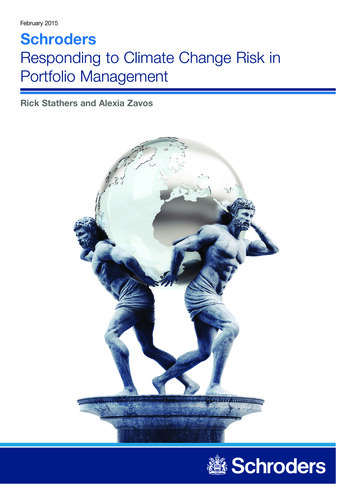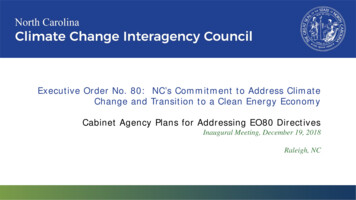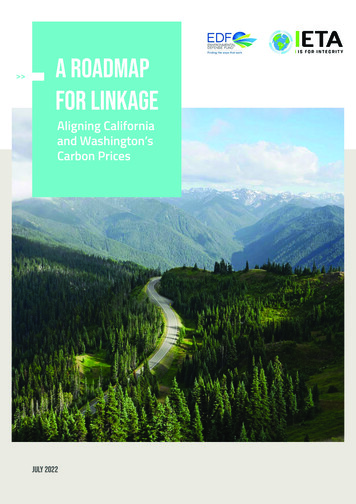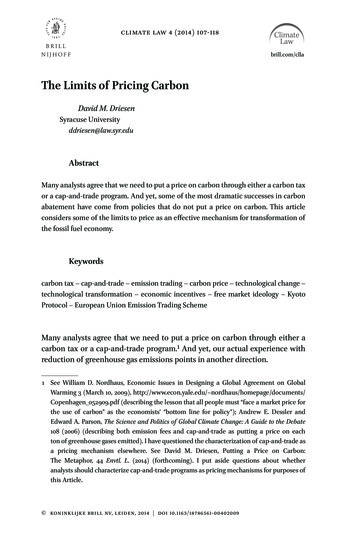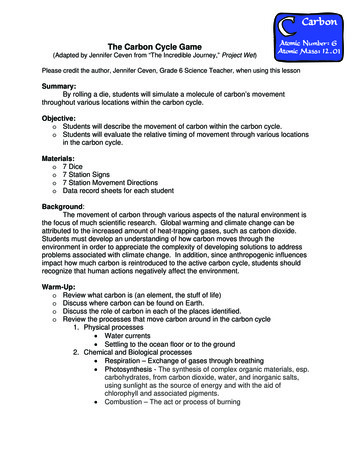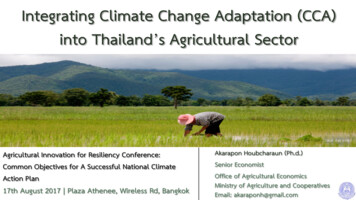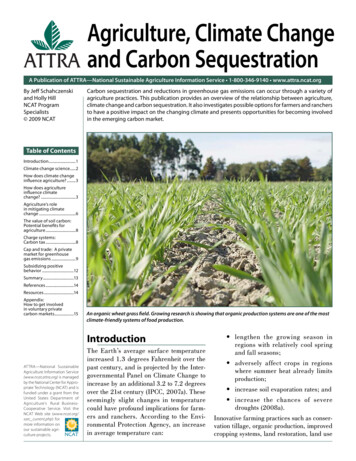
Transcription
Agriculture, Climate Changeand Carbon SequestrationA Publication of ATTRA—National Sustainable Agriculture Information Service 1-800-346-9140 www.attra.ncat.orgBy Jeff Schahczenskiand Holly HillNCAT ProgramSpecialists 2009 NCATCarbon sequestration and reductions in greenhouse gas emissions can occur through a variety ofagriculture practices. This publication provides an overview of the relationship between agriculture,climate change and carbon sequestration. It also investigates possible options for farmers and ranchersto have a positive impact on the changing climate and presents opportunities for becoming involvedin the emerging carbon market.Table of ContentsIntroduction.1Climate change science.2How does climate changeinfluence agriculture? .3How does agricultureinfluence climatechange? .3Agriculture’s rolein mitigating climatechange .6The value of soil carbon:Potential benefits foragriculture .8Charge systems:Carbon tax .8Cap and trade: A privatemarket for greenhousegas emissions .9Subsidizing positivebehavior .12Summary .13References .14Resources .14Appendix:How to get involvedin voluntary privatecarbon markets.15An organic wheat grass field. Growing research is showing that organic production systems are one of the mostclimate-friendly systems of food production.IntroductionATTRA—National SustainableAgriculture Information Service(www.ncat.attra.org) is managedby the National Center for Appropriate Technology (NCAT) and isfunded under a grant from theUnited States Department ofAgriculture’s Rural BusinessCooperative Service. Visit theNCAT Web site (www.ncat.org/sarc current.php) formore information onour sustainable agriculture projects.The Earth’s average surface temperatureincreased 1.3 degrees Fahrenheit over thepast century, and is projected by the Intergovernmental Panel on Climate Change toincrease by an additional 3.2 to 7.2 degreesover the 21st century (IPCC, 2007a). Theseseemingly slight changes in temperaturecould have profound implications for farmers and ranchers. According to the Environmental Protection Agency, an increasein average temperature can: lengthen the growing season inregions with relatively cool springand fall seasons; adversely affect crops in regionswhere summer heat already limitsproduction; increase soil evaporation rates; and increase the chances of severedroughts (2008a).Innovative farming practices such as conservation tillage, organic production, improvedcropping systems, land restoration, land use
Related ATTRAPublicationsConservation TillagePursuing ConservationTillage Systemsfor Organic CropProductionEnergy Saving Tipsfor Irrigatorschange and irrigation and water management, are ways that farmers can addressclimate change. Good management practices have multiple benefits that may alsoenhance profitability, improve farm energyefficiency and boost air and soil quality.habitable. Increased levels of greenhousegases enhance the naturally occurringgreenhouse effect by trapping even more ofthe sun’s heat, resulting in a global warming effect. Figure 1 illustrates the naturaland enhanced greenhouse effects (Pew Center on Global Climate Change, 2008).Climate change scienceThe primary greenhouse gases associatedwith agriculture are carbon dioxide (CO2),methane (CH4 ) and nitrous oxide (N20).Although carbon dioxide is the most prevalent greenhouse gas in the atmosphere,nitrous oxide and methane have longerdurations in the atmosphere and absorbmore long-wave radiation. Therefore, smallquantities of methane and nitrous oxide canhave significant effects on climate change.Natural shifts in global temperatures haveoccurred throughout human history. The20th century, however, has seen a rapid risein global temperatures. Scientists attributethe temp increase to a rise in carbon dioxide and other greenhouse gases releasedfrom the burning of fossil fuels, deforestation, agriculture and other industrial processes. Scientists refer to this phenomenonas the enhanced greenhouse effect.Anaerobic Digestionof Animal Wastes:Factors to ConsiderThe naturally occurring greenhouse effecttraps the heat of the sun before it canbe released back into space. This allowsthe Earth’s surface to remain warm andBiodiesel:The SustainabilityDimensionsFigure 1. The Greenhouse EffectEthanol Opportunitiesand QuestionsRenewable EnergyOpportunities onthe FarmFederal Resources forSustainable Farmingand RanchingSeveral excellent resources and fact sheetsexplain the greenhouse effect and thescience behind climate change. See theResources section for information on howto obtain copies.Source: The National Academy of Sciences. ural Greenhouse EffectEnhanced Greenhouse EffectThe greenhouse effect is a natural warming process. Carbon dioxide (CO2) and certain other gases are always present in theatmosphere. These gases create a warming effect that has some similarity to thewarming inside a greenhouse, hence thename “greenhouse effect.”Increasing the amount of greenhouse gasesintensifies the greenhouse effect. This sideof the globe simulates conditions today,roughly two centuries after the IndustrialRevolution began.Illustration of the greenhouse effect (courtesy of the Marion Koshland Science Museum of the National Academy ofSciences). Visible sunlight passes through the atmosphere without being absorbed. Some of the sunlight striking theearth (1) is absorbed and converted to heat, which warms the surface. The surface (2) emits infrared radiation to theatmosphere, where some of it (3) is absorbed by greenhouse gases and (4) re-emitted toward the surface; some ofthe heat is not trapped by greenhouse gases and (5) escapes into space. Human activities that emit additional greenhouse gases to the atmosphere (6) increase the amount of infrared radiation that gets absorbed before escaping intospace, thus enhancing the greenhouse effect and amplifying the warming of the earth.Page 2ATTRAAgriculture, Climate Change and Carbon Sequestration
How does climate changeinfluence agriculture?Climate change may have beneficial as wellas detrimental consequences for agriculture. Some research indicates that warmertemperatures lengthen growing seasons andincreased carbon dioxide in the air resultsin higher yields from some crops. A warming climate and decreasing soil moisture canalso result in production patterns shiftingnorthward and an increasing need for irrigation. Changes, however, will likely varysignificantly by region. Geography will playa large role in how agriculture might benefitfrom climate change. While projections lookfavorable for some areas, the potential ofincreased climate variability and extremesare not necessarily considered. Benefits toagriculture might be offset by an increasedlikelihood of heat waves, drought, severethunderstorms and tornadoes. An increasein climate variability makes adaptation difficult for farmers.The U.S. Department of Agriculturereleased a report in May 2008 that focusedon the effects of climate on agriculture,specifically on cropping systems, pastureand grazing lands and animal management(Backlund et al., 2008). The following findings are excerpted from the report: With increased carbon dioxide andhigher temperatures, the life cycleof grain and oilseed crops will likelyprogress more rapidly. The marketable yield of many horticultural crops, such as tomatoes,onions and fruits, is very likely tobe more sensitive to climate changethan grain and oilseed crops. Climate change is likely to lead to anorthern migration of weeds. Manyweeds respond more positively toincreasing carbon dioxide than mostcash crops. Disease pressure on crops and domestic animals will likely increase withearlier springs and warmer winters. Projected increases in temperature anda lengthening of the growing seasonwww.attra.ncat.orgwill likely extend forage productioninto late fall and early spring. Climate change-induced shifts inplant species are already under wayin rangelands. The establishmentof perennial herbaceous species isreducing soil water availability earlyin the growing season. Higher temperatures will very likelyreduce livestock production duringthe summer season, but these losseswill be partially offset by warmertemperatures during the winterseason (Backlund et al., 2008).How does agricultureinfluence climate change?Agriculture’s contribution togreenhouse gas emissionsAgriculture activities serve as both sourcesand sinks for greenhouse gases. Agriculturesinks of greenhouse gases are reservoirs ofcarbon that have been removed from theatmosphere through the process of biological carbon sequestration.Conservation tillage,organicproduction, covercropping and croprotations can drastically increase theamount of carbonstored in soils.The primary sources of greenhouse gases inagriculture are the production of nitrogenbased fertilizers; the combustion of fossil fuelssuch as coal, gasoline, diesel fuel and naturalgas; and waste management. Livestock entericfermentation, or the fermentation that takesplace in the digestive systems of ruminantanimals, results in methane emissions.Carbon dioxide is removed from the atmosphere and converted to organic carbonthrough the process of photosynthesis. Asorganic carbon decomposes, it is convertedback to carbon dioxide through the processof respiration. Conservation tillage, organicproduction, cover cropping and crop rotations can drastically increase the amount ofcarbon stored in soils.In 2005, agriculture accounted for from10 to 12 percent of total global humancaused emissions of greenhouse gases,according the Intergovernmental Panel onClimate Change (IPCC, 2007b). In theUnited States, greenhouse gas emissionsATTRAPage 3
from agriculture account for 8 percentof all emissions and have increasedsince 1990 (Congressional ResearchService, 2008). Figure 2 presents recentdata in carbon dioxide equivalents (CO2e).Greenhouse gases have varying globalwarming potentials, therefore climatescientists use carbon dioxide equivalentsto calculate a universal measurement ofgreenhouse gas emissions.Figure 2. Greenhouse gas emissions and carbon sinks in agricultural activities, 1990-2005 (CO2 lion metric tons CO2 equivalent (MMTCO2-Eq)U.S. Agricultural ActivitiesGHG Emissions (CH4 and N2O)Agriculture Soil ManagementaEnteric FermentationbManure managementRice CultivationAgricultural Residue BurningSubtotalCarbon SinksAgricultural SoilsOtherSubtotalNet Emissions, a(32.4)503.9(31.7)na(31.7)508.4Attributable CO2 emissions: cFossil fuel/mobile combustion46.857.350.945.552.6% All Emissions, Agricultured% Total Sinks, %% Total Emissions, Forestry% Total Sinks, 0.4(828.5)6,431.96,787.1(801.0)5,986.1Total GHG Emissions, All Sectors 6,242.0Total Carbon SInks, All Sectors(712.8)Net Emissions, All Sectors5,529.2Source: EPA, Inventory of U.S. Grenhouse Gas Emissions and Sinks: 1990-2005, April 2007, yreport.html]. Table ES-2, Table 2-13, Table 6-1, Table 7-1, and Table 7-3. EPA data are reported i teragrams (tg.), which are equivalent toone million metric tons each.a. N2O emissions from soil management and nutrient/chemical applications on croplands.b. CH4 emissions from ruminant livestock.c. Emissions from fossil fuel/mobile combustion associated with energy use in the U.S. agriculture sector (excluded from EPA’s reported GHGemissions for agricultural activities).d. Does not include attributable CO2 emissions from fossil fuel/mobile combustion.e. Change in forest stocks and carbon uptake from urban trees and landfilled yard trimmings.Page 4ATTRAAgriculture, Climate Change and Carbon Sequestration
Figure 3. Agricultural greenhouse gas emissions, average from 2001 to 2005. Source: EPA, 2007Inventory report, April 2007. ort.html2.1.1.%NTERIC fERMENTATION #( 2.!G rESIDUE bURNING #( . /3.-ANURE management . / 4.-ANURE management #( 5.2ICE cULTIVATION #( 6.!G sOIL management . /3.4.5. 6.Figure 3 illustrates agricultural greenhouse gasemissions by source in the United States.The following is evident from the information in Figures 2 and 3: Despite some improvement incertain areas since 1990, theU.S. agricultural production sector increased its greenhouse gasemissions and expanded its role inclimate change. The U.S. agricultural productionsector is a net emitter of greenhouse gas emissions. That is,agricultural production annuallycreates more greenhouse gas emissions than it captures, despite thepotential for the sector to sequester higher levels of carbon withmanagement changes. The U.S. agricultural productionsector contributes more greenhousegas emissions from methane (CH4)and nitrous oxide (N2O) than fromcarbon dioxide (CO2). Agricultural soil management isthe single greatest contributor togreenhouse gas emissions from theU.S agricultural production sector.Enteric fermentation (f latulenceand belches of ruminants) andmanure management are also largecontributors.www.attra.ncat.org Carbon sequestrationCarbon sequestration in the agriculture sector refers to the capacity of agriculture landsand forests to remove carbon dioxide fromthe atmosphere. Carbon dioxide is absorbedby trees, plants and crops through photosynthesis and stored as carbon in biomassin tree trunks, branches, foliage and rootsand soils (EPA, 2008b). Forests and stablegrasslands are referred to as carbon sinksbecause they can store large amounts ofcarbon in their vegetation and root systemsfor long periods of time. Soils are the largest terrestrial sink for carbon on the planet.The ability of agriculture lands to store orsequester carbon depends on several factors, including climate, soil type, type ofcrop or vegetation cover and managementpractices.The amount of carbon stored in soil organicmatter is influenced by the addition of carbon from dead plant material and carbonlosses from respiration, the decompositionprocess and both natural and human disturbance of the soil. By employing farmingpractices that involve minimal disturbanceof the soil and encourage carbon sequestration, farmers may be able to slow or evenreverse the loss of carbon from their fields.In the United States, forest and croplandscurrently sequester the equivalent of 12percent of U.S. carbon dioxide emissionsfrom the energy, transportation and industrial sectors (EPA, 2008b).ATTRAPage 5
Figure 4. Carbon pools in forestry and agriculture. Source: EPA. www.epa.gov/sequestration/local scale.htmlAtmospheric carbon is fixed by trees andother vegetation through photosynthesis.Carbon is lost back to the atmospherethrough respiration and decompositonof organic matter.Aboveground carbon: Stem Branches FoliageFallen leaves andbranches addcarbon to soils.Some carbon is internallytransferred from abovegroundto belowground carbon soils.Belowground carbon: Roots LitterSome carbon is transferred frombelowground carbon (for example,root mortality) to the soils.Figure 4, adapted from the EPA, illustratesthe different processes through which treesand soils can gain and lose carbon.Agriculture’s role inmitigating climate changeSeveral farming practices and technologies can reduce greenhouse gas emissionsand prevent climate change by enhancingcarbon storage in soils; preserving existingsoil carbon; and reducing carbon dioxide,methane and nitrous oxide emissions.Page 6ATTRACarbon is lost to theatmosphere throughsoil respiration.Soil carbon: Organic InorganicConservation tillage andcover cropsConservation tillage refers to a numberof strategies and techniques for establishing crops in the residue of previous crops,which are purposely left on the soil surface.Reducing tillage reduces soil disturbanceand helps mitigate the release of soil carbon into the atmosphere. Conservation tillage also improves the carbon sequestrationcapacity of the soil. Additional benefits ofconservation tillage include improved waterconservation, reduced soil erosion, reducedAgriculture, Climate Change and Carbon Sequestration
fuel consumption, reduced compaction,increased planting and harvesting flexibility,reduced labor requirements and improvedsoil tilth. For further information, see theATTRA publication Conservation Tillage.Improved cropping andorganic systemsRecent reports have investigated the potentialof organic agriculture to reduce greenhousegas emissions (Rodale Institute, 2008).Organic systems of production increase soilorganic matter levels through the use of composted animal manures and cover crops.Organic cropping systems also eliminate theemissions from the production and transportation of synthetic fertilizers. Components oforganic agriculture could be implementedwith other sustainable farming systems,such as conservation tillage, to furtherincrease climate change mitigation potential. See the ATTRA publication PursuingConservation Tillage Systems for Organic CropProduction for more information.Generally, conservation farming practices that conserve moisture, improve yieldpotential and reduce erosion and fuel costsalso increase soil carbon. Examples of practices that reduce carbon dioxide emissionsand increase soil carbon include directseeding, field windbreaks, rotational grazing, perennial forage crops, reduced summer fallow and proper straw management(Alberta Agriculture and Rural Development, 2000). Using higher-yielding cropsor varieties and maximizing yield potentialcan also increase soil carbon.Land restoration andland use changesLand restoration and land use changesthat encourage the conservation andimprovement of soil, water and air quality typically reduce greenhouse gas emissions. Modifications to grazing practices,such as implementing sustainable stockingrates, rotational grazing and seasonal useof rangeland, can lead to greenhouse gasreductions. Converting marginal croplandto trees or grass maximizes carbon storageon land that is less suitable for crops.www.attra.ncat.orgIrrigation and watermanagementImprovements in water use efficiency,through measures such as irrigation systemmechanical improvements coupled with areduction in operating hours; drip irrigation technologies; and center-pivot irrigation systems, can significantly reduce theamount of water and nitrogen applied tothe cropping system. This reduces greenhouse emissions of nitrous oxide and waterwithdrawals. For more information, see theATTRA publication Energy Saving Tipsfor Irrigators.Nitrogen use efficiencyImproving fertilizer efficiency throughpractices like precision farming using GPStracking can reduce nitrous oxide emissions. Other strategies include the use ofcover crops and manures (both green andanimal); nitrogen-fixing crop rotations;composting and compost teas; and integrated pest management. The ATTRA FarmEnergy Web site contains information aboutreducing nitrogen fertilizer on the farm atthe following link: vationfarmingpracticesthat conservemoisture, improveyield potential andreduce erosionand fuel costs alsoincrease soil carbon.Methane captureLarge emissions of methane and nitrousoxide are attributable to livestock wastetreatment, especially in dairies. Agriculturemethane collection and combustion systemsinclude covered lagoons and complete mixand plug flow digesters. Anaerobic digestionconverts animal waste to energy by capturing methane and preventing it from beingreleased into the atmosphere. The capturedmethane can be used to fuel a variety ofon-farm applications, as well as to generate electricity. Additional benefits includereducing odors from livestock manureand reducing labor costs associated withmanure removal. For more information onanaerobic digestion, see the ATTRA publication Anaerobic Digestion of Animal Wastes:Factors to Consider.ATTRAPage 7
BiofuelsThere is significant scientific controversyregarding whether biofuels — particularlythose derived from oilseeds (biodiesel),feed corn (ethanol) or even from cellulosicsources — are carbon neutral. To ascertain the true climate neutrality of biofuelsrequires a careful life-cycle analysis of thespecific biofuel under consideration. Also,an analysis is needed to understand whatthe global land use change implications willbe if farmers grow more of a specific biofuelfeedstock. For further information on biofuels, see the ATTRA publications Biodiesel:The Sustainability Dimensions and EthanolOpportunities and Questions.C“reating farmand forestrysystems withstrong incentives forgrowing soil carboncould well be at thecenter of climatestabilization.”(Mazza, 2007)Other renewable energy optionsRenewable energy opportunities such aswind and solar also present significantopportunities for the agriculture sector toreduce greenhouse gas emissions. For further information about these options, seethe ATTRA publication Renewable EnergyOpportunities on the Farm.The value of soil carbon:Potential benefits foragricultureAs Mazza (2007) has remarked, “creatingfarm and forestry systems with strong incentives for growing soil carbon could well beat the center of climate stabilization.”Thus, a new crop that farmers and ranchersmay grow in the future is carbon. The NaturalResources Conservation Service, part of theUSDA, has long been a promoter of managingcarbon in efforts to improve soil quality.As with any crop, farmers and ranchersneed a market for this new crop, as wellas a price that will make it more profitable to grow. From a broader social context, the questions of who will purchasethis new crop and what is a fair price arealso of private and public importance. Voluntary private carbon markets exist in theUnited States. Federal government marketsare expected to be created soon. How tovalue carbon from the perspective of thePage 8ATTRAindividual farmer and rancher, as well associety at large, is the heart of understanding the role agriculture can play in carbonsequestration and climate stabilization.The two most frequently discussed systemsto create value for offsetting greenhouse gasemissions are known as carbon taxation andcap and trade. Government subsidies are discussed less often, but will also play a role ingreenhouse gas emission reductions.Charge systems: Carbon taxBy taxing every ton of carbon in fossil fuelsor every ton of greenhouse gas companiesemit, entities that emit greenhouse gases oruse carbon-based fuels will have an incentive to switch to alternative renewable fuels,invest in technology changes to use carbonbased fuels more efficiently and in generaladopt practices that would lower their level ofgreenhouse gas emissions. Thus a carbon orgreenhouse gas emission tax values carbonin negative terms of tax avoidance. Thosefarms and ranches that emit or use less carbon-intensive fuels pay a smaller tax.From the perspective of farmers and ranchers, a carbon tax would increase the directand indirect costs of agricultural production.Farmers and ranchers use carbon-basedfuels directly in the forms of petroleum andnatural gas and indirectly in the forms ofcarbon-based fertilizers and pesticides andfuel-intensive inputs. Thus, a carbon taxcould move farmers and ranchers to shift tosystems of production that either eliminatethe use of fossil fuels and inputs or at leastimprove the efficiency of their use.However, proponents of carbon taxes havegenerally sought to exclude the agriculturesector from such taxation. For the mostpart, carbon tax proponents have beenmore interested in placing greenhouse gasemission taxes on upstream producers ofthe original source products. This includescoal, petroleum and natural gas producers and major emitters such as large electric utilities. Nonetheless, as people workto reduce greenhouse gas emissions, thepotential to place a carbon tax on sectorslike agriculture may become more likely.Agriculture, Climate Change and Carbon Sequestration
Benefits of a carbon tax forfarmers and ranchersA major benefit of a carbon or greenhousegas emission tax would be the creation of astream of tax revenue that the governmentcould use to further induce the practiceand technology changes necessary to lowergreenhouse gas emissions. For example,many of the current agriculture conservation programs, such as the EnvironmentalQuality Incentive Program and the newerConservation Stewardship Program, support improvements in soil quality and couldbe funded in part from emission or carbontaxes, thereby providing a revenue sourceto subsidize those who adopt or maintainemission-reduction practices or carbonsequestration activities. See the ATTRApublication Federal Resources for Sustainable Farming and Ranching for more information. Tax revenues could also assist inthe support of conservation programs likethe Conservation Reserve Program, whichworks to keep sensitive and highly erodiblelands out of production since these landssequester soil carbon.Another benefit of this approach is that atax provides a clear and stable cost to current practices. A tax also makes it easierto determine changes that will be moreprofitable in a new cost environment. Forinstance, if a concentrated animal feedingoperation understood the cost of their emissions as expressed by their emission tax, itwould be easier for the operation to determine alternatives to current practices thatwould be cost efficient. At a high enough taxrate, installing methane digesters to lowergreenhouse gas emission would becomeeconomically feasible.Finally, it has been argued that a carbontax approach is cost effective in implementation, at least when compared to thecap-and-trade method of achieving greenhouse gas emissions reductions. As recentCongressional Budget Office report states:“available research suggests that in the nearterm, the net benefits (benefits minus costs)of a tax could be roughly five times greaterwww.attra.ncat.orgthan the net benefits of an inflexible cap”(Congressional Budget Office, 2008).Downside of a carbon taxThe introduction of any tax results in discussions of where the burden of taxationlies and issues of equity. In short, taxationis about who pays and who does not. Newtaxes also often result in a public discussion of the fairness of the tax. There is logicto the argument that the burden of a carbon or greenhouse gas emission tax shouldbe placed fi rst and foremost on those whoeither create carbon-intensive fuels or thosewho are the largest emitters of greenhousegases. The greatest source of greenhousegas emissions in the United States is thecombustion of fossil fuels. Since agricultureuses a small percentage of U.S. fossil fuels,an argument can be made that the burdenof taxation should not to fall on this sector.Still, agriculture is heavily dependent onfossil fuels and any carbon or greenhousegas emission tax would likely be costly.Atax providesa clear andstable costto current practices.The ability of any individual farmer orrancher to pass on the increased costs offossil fuels that this kind of taxation wouldcreate is much more limited than in othersectors of the economy. For instance, if acarbon tax is placed on diesel fuel, dieselfuel manufacturers can more easily pass onthe tax burden to the consumers of the diesel. The ability to pass on costs to consumers is greater in industries where there islittle product substitution and where a fewproducers dominate the market. This is notthe case for farmers and ranchers, giventheir relative lack of market concentrationand power.Cap and trade: A private marketfor greenhouse gas emissionsA government-sponsored cap-and-trade system would create a new market for greenhouse gas emissions by creating a new property right — the right to emit.The market is created by a governmentthat sets a limit or cap on total greenhousegas emissions allowed. Companies thatATTRAPage 9
emit greenhouse gases are issued emissionpermits that allow a certain amount of emissions. Companies and groups that exceedtheir allowed emissions must purchase offsets from other entities that pollute less thantheir allowance or from entities that sequester carbon.These exchangeable emission permits, oftencalled allowances, are measured in tons ofcarbon dioxide equivalents per year. Carbondioxide equivalents provide a common measure for all greenhouse gas emissions and arecalculated by converting greenhouse gasesinto carbon dioxide equivalents according totheir global warming potential.Over time, the government will continually lower the total level of allowances tomeet an established level of acceptabletotal emissions. As the supply of allowances decreases, the value of the allowances will rise or fall depending on demandand on the ability of emitters to make necessary changes to reduce emissions orpurchase offsets from groups more capable ofreducing emissions.Benefits for farmers andranchersDepending on the practices adopted,farmers and ranchers could be a sourceof inexpensive carbon reduction and capture the value of these allowances as offsets. In short, the value of offsets wouldbecome the market price of carbon equivalents. This would become the value of thenew crop — carbon — that farmers andranchers could grow.From the May 26, 2008 issue of HighCountry News:For example, if a farmer shifted to anorganic system of production, measurableimprovements in the ability of the farmer tosequester carbon could be veri
Page 4 ATTRA Agriculture, Climate Change and Carbon Sequestration from agriculture account for 8 percent of all emissions and have increased since 1990 (Congressional Research Service, 2008). Figure 2 presents recent data in carbon dioxide equivalents (CO

